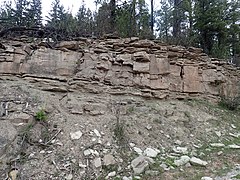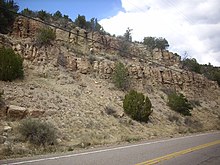Madera Group
| Madera Group | |
|---|---|
| Stratigraphic range: | |
 Madera Group limestone beds in the San Pedro Mountains, New Mexico | |
| Type | Group |
| Sub-units | Gray Mesa Formation, Atrasado Formation |
| Underlies | Abo Formation, Bursum Formation |
| Overlies | Sandia Formation |
| Thickness | 390 m (maximum subsurface) |
| Lithology | |
| Primary | Limestone |
| Location | |
| Coordinates | 35°13′23″N 106°22′44″W / 35.223°N 106.379°W |
| Region | New Mexico |
| Country | United States |
| Type section | |
| Named for | Town of La Madera, New Mexico |
| Named by | Charles Rollin Keyes |
| Year defined | 1903 |
Outcrops of Madera Group in New Mexico | |
The Madera Group is a group of geologic formations in northern New Mexico. Its fossil assemblage dates the formation to the middle to late Pennsylvanian period.
Description
The group consists primarily of marine limestones, and it is exposed in the Sandia Mountains,[1] the Lucero Uplift (34°37′16″N 107°17′56″W / 34.621°N 107.299°W),[2] the western Jemez Mountains,[3] the Sangre de Cristo Mountains,[4][5] and in the Manzano Mountains.[6]
The lower section of the group tends to be a gray limestone and the upper an arkosic limestone, and these have been divided into the La Pasada Formation and Alamitos Formation in the southern Sangre de Cristo Mountains.[5] In the Manzano Mountains, the Madera has been divided into the Los Moyos, Wild Cow, and Bursum Formations.[6] Another proposed division in the southeastern Sangre de Cristo Mountains is into the Porvenir and Alamitos Formations.[7]

Barry Kues and Katherine Giles have recommended the division of the Madera Group into the Gray Mesa Formation and Atrasado Formation in its western and southern exposures, which extend from the Nacimiento Mountains through the Lucero Uplift to the Los Robles Mountains. For the eastern exposures of the Sandia and Manzano Mountains and Estancia Basin, they recommend division into the Los Moyos Formation and Wild Cow Formation. They recommend abandoning the name Madera Group in the Sangre de Cristo Mountains.[8] More recently, Spencer G. Lucas and coinvestigators have recommended abandoning the names Los Moyos Formation and Wild Cow Formation and using Grey Mesa Formation and Atrasado Formation throughout the Madera Group.[9]
The group is underlain at most locations by the Sandia Formation, with its base typically placed at the first massive marine limestone bed above the shales of the Sandia Formation. It is overlain everywhere by the Abo Formation or its equivalents, with the transition typically gradational, with the base of the Abo placed at the top of the last massive marine limestone bed below the fluvial redbeds typical of the Abo. The transitional zone between the Madera Group and the Abo Formation is sometimes assigned to the Bursum Formation, which is not included in the Madera Group.[8]
Fossils
The exposures near Jemez Springs include some of the richest brachiopod fossil beds in North America. Crinoid stems and bryozoans are also part of the fossil assemblage. The formation is also exposed in the canyon of Rio Grande del Rancho south of Talpa, New Mexico, where brachiopods, crinoids, rugose coral, and graptolite fossils can be found. The fossil assemblage dates the Madera Group to the middle to late Pennsylvanian.[10]
History of investigation
In 1903, C.R. Keyes applied the name, Madera limestone, to what he identified as upper Carboniferous beds in the Sandia Mountains. The unit was named for the town of La Madera.[1] The name was subsequently applied to Pennsylvanian marine limestones throughout central and northern New Mexico. D.A. Myers first proposed that the unit be raised to group rank in 1973.[6]
The Pennsylvanian stratigraphy of New Mexico has historically been unusually complex and inconsistent, with dozens of names for groups, formations, and members.[11][9] Kues and Giles recommended that the name Madera Group be applied to similar exposures of shelf and marginal basin beds of Desmoinean (upper Moscovian) to early Virgilian age found from north-central and central New Mexico south along the west side of the Orogrande Basin as far as the Caballo and Robledo Mountains.[12]
See also
Footnotes
- ^ a b Keyes 1903.
- ^ Kelley & Wood 1946.
- ^ Wood & Northrop 1946.
- ^ Bolyard 1959.
- ^ a b Miller, Montgomery & Sutherland 1963.
- ^ a b c Myers 1973.
- ^ Baltz & Myers 1983.
- ^ a b Kues & Giles 2004, pp. 98–100.
- ^ a b Lucas, Krainer & Vachard 2016.
- ^ Sutherland & Harlow 1967.
- ^ Kues & Giles 2004, p. 100.
- ^ Kues & Giles 2004, p. 101.
References
- Baltz, E.H.; Myers, D.A. (1983). "Porvenir Formation (new name) - and other revisions of nomenclature of Mississippian, Pennsylvanian, and Lower Permian rocks, southeastern Sangre de Cristo Mountains, New Mexico". Contributions to Stratigraphy. Bulletin 1537-B.
- Bolyard, D.W. (1959). "Pennsylvanian and Permian Stratigraphy in Sangre de Cristo Mountains Between La Veta Pass and Westcliffe, Colorado". AAPG Bulletin. 43 (8): 1896–1939. doi:10.1306/0BDA5E79-16BD-11D7-8645000102C1865D.
- Kelley, V.C.; Wood, G.H. Jr. (1946). "Geology of the Lucero uplift, Valencia, Socorro, and Bernalillo Counties, New Mexico". U.S. Geological Survey Oil and Gas Investigations. Preliminary Map OM-47. Retrieved 22 May 2019.
- Keyes, C.R. (1903). "Geological formations of New Mexico". Report of the Governor of New Mexico to the Secretary of the Interior, 1903. U.S. Government Printing Office. pp. 337–340.
- Kues, B.S.; Giles, K.A. (2004). "The late Paleozoic Ancestral Rocky Mountain system in New Mexico". In Mack, G.H.; Giles, K.A. (eds.). The geology of New Mexico. A geologic history: New Mexico Geological Society Special Volume 11. pp. 95–136. ISBN 9781585460106.
- Lindsey, D.A. (1995). "Geologic map of the McCarty Park quadrangle, Costilla and Huerfano Counties, Colorado". U.S. Geological Survey Miscellaneous Field Studies. Map MF-2282.
- Lucas, Spencer G.; Krainer, Karl; Vachard, Daniel (2016). "The Pennsylvanian section at Priest Canyon, southern Manzano Mountains, New Mexico" (PDF). New Mexico Geological Society Field Conference Series. 67. Retrieved 11 June 2020.
- Miller, John P.; Montgomery, Arthur; Sutherland, Patrick K. (1963). "Geology of Part of the Southern Sangre de Cristo Mountains, New Mexico" (PDF). New Mexico Bureau of Mines and Mineral Resources Memoir Series. 11.
- Myers, D.A. (1973). "The Upper Paleozoic Madera Group in the Manzano Mountains, New Mexico" (PDF). Contributions to Stratigraphy. Bulletin 1372-F. Retrieved 13 September 2020.
- Sutherland, Patrick K.; Harlow, Francis H. (1967). "Late Pennsylvanian Brachiopods From North-Central New Mexico". Journal of Paleontology. 41 (5): 1065–1089. JSTOR 1302076.
- Wood, G.H.; Northrop, S.A. (1946). "Geology of Nacimiento Mountains, San Pedro Mountain, and adjacent plateaus in parts of Sandoval and Rio Arriba Counties, New Mexico". U.S. Geological Survey Oil and Gas Investigations. Preliminary Map OM-57.

